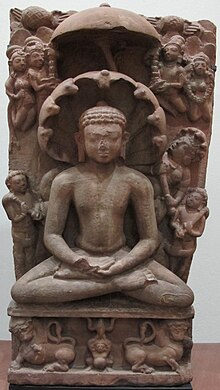Parshvanatha
| Parshvanatha | |
|---|---|
| 23rd Jain Tirthankara | |

Image of Tīrthankara Parshvanatha (Victoria and Albert Museum, 6th-7th Century)
|
|
| Symbol | Snake |
| Height | 9 cubits (13.5 feet) |
| Age | 100 years |
| Color | Blue |
| Spouse | Prabhavati |
| Parents |
|
| Preceded by | Neminatha |
| Succeeded by | Mahavira |
| Born | Varanasi |
| Moksha | Shikharji |
Parshvanatha (Pārśvanātha), also known as Parshva (Pārśva), was the twenty-third Tirthankara of Jainism. He is the earliest Jain leader (c. 872 – c. 772 BCE) for whom there is reasonable evidence of having been a historical figure.
Circumstantial evidence including a description of the teachings of Parshvanatha in the Sayings of the Seers, dictates that Parshvanatha can be viewed as a historical figure.
Parshvanatha was born on the tenth day of the dark half of the month of Paush to King Asvasena and Queen Vamadevi of Benaras (now Varanasi). He belonged to the Ikshvaku dynasty. He assumed and began to practice the twelve basic vows of the adult Jain householder when he reached the age of eight.
Parshvanatha lived as formal prince of Varanasi and at the age of thirty, he renounced the world to become a monk. He meditated for eighty-four days before attaining Kevala Jnana. He achieved moksha at the age of one hundred atop Shikharji, which is known today as the Parasnath Hills after him. Parshvanatha was called purisādāṇīya (beloved of men), a name which shows that he must have been a genial personality. He remains beloved among Jains.
According to the Kalpa Sūtra, Parshvanatha had 164,000 śrāvakas (male lay followers) and 327,000 śrāvikās (female lay followers) and 16,000 sādhus (monks) and 38,000 sādhvīs (nuns). He had eight ganadharas (chief monks): Śubhadatta, Āryaghoṣa, Vasiṣṭha, Brahmacāri, Soma, Śrīdhara, Vīrabhadra and Yaśas. After his death, the ganadhara Śubhadatta became the head of the monastic order. He was then succeeded by Haridatta, Āryasamudra and Keśī.
...
Wikipedia
